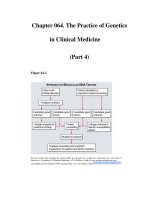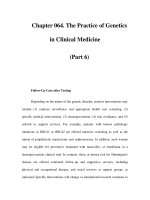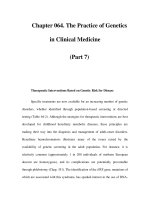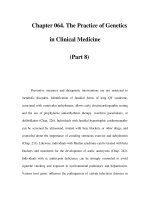Chapter 124. Sexually Transmitted Infections: Overview and Clinical Approach (Part 20) Proctitis, pdf
Bạn đang xem bản rút gọn của tài liệu. Xem và tải ngay bản đầy đủ của tài liệu tại đây (77.34 KB, 5 trang )
Chapter 124. Sexually Transmitted Infections:
Overview and Clinical Approach
(Part 20)
Proctitis, Proctocolitis, Enterocolitis, and Enteritis: Treatment
Acute proctitis in persons who have practiced receptive anorectal
intercourse is usually sexually acquired. Such patients should undergo anoscopy to
detect rectal ulcers or vesicles and petechiae after swabbing of the rectal mucosa;
to examine rectal exudates for PMNs and gram-negative diplococci; and to obtain
rectal swab specimens for testing for rectal gonorrhea, chlamydial infection,
herpes, and syphilis. Pending test results, patients with proctitis should receive
empirical syndromic treatment—e.g., with ceftriaxone (a single IM dose of 125
mg for gonorrhea) plus doxycycline (100 mg PO twice daily for 7 days for
possible chlamydial infection) plus treatment for herpes or syphilis if indicated.
Prevention and Control of STIs
Prevention and control of STIs require the following:
1. Reduction of the average rate of sexual exposure to STIs
through alteration of sexual risk behaviors and behavioral norms among
both susceptible and infected persons in all population groups. The
necessary changes include reduction in the total number of sexual partners
and the number of concurrent sexual partners.
2. Reduction of the efficiency of transmission through the
promotion of safer sexual practices, the use of condoms during casual or
commercial sex, vaccination against HBV and HPV infection, male
circumcision, and a growing number of other approaches (e.g., early
detection and treatment of other STIs to reduce the efficiency of sexual
transmission of HIV). We now know from longitudinal studies over the
past decade that consistent condom use is associated with significant
protection of both males and females against all STIs that have been
examined, including HIV, HPV, and HSV infections as well as gonorrhea
and chlamydial infection. The only exceptions are probably sexually
transmitted Phthirus pubis and Sarcoptes scabiei infestations.
3. Shortening of the duration of infectivity of STIs through early
detection and curative or suppressive treatment of patients and their sexual
partners.
Financial and time constraints imposed by managed-care practice patterns,
along with the reluctance of some clinicians to ask questions about stigmatized
sexual behaviors, often curtail screening and prevention services. As outlined in
Fig. 124-8, the success of clinicians' efforts to detect and treat STIs depends in part
on societal efforts to teach young people how to recognize symptoms of STIs; to
motivate those with symptoms to seek care promptly; and to make high-quality,
appropriate care accessible, affordable, and acceptable, especially to the young
indigent patients most likely to acquire an STI.
Figure 124-8
Critical control points for preventive and clinical interventions
against
sexually transmitted diseases (STDs). [
Adapted from HT Waller and MA Piot:
Bull World Health Organ 41:75, 1969 and 4
3:1, 1970; and from "Resource
allocation model for public health planning—
a case study of tuberculosis
control," Bull World Health Organ 84(Suppl), 1973.]
Since many infected individuals develop no symptoms or fail to recognize
and report symptoms, clinicians should routinely perform an STI risk assessment
for teenagers and young adults as a guide to selective screening. U.S. Preventive
Services Task Force Guidelines recommend screening sexually active female
patients ≤25 years of age for C. trachomatis whenever they present for health care
(at least once a year); older women should be tested if they have more than one
sexual partner, have begun a new sexual relationship since the previous test, or
have another STI diagnosed. In the United States, widespread selective screening
of young women for cervical C. trachomatis infection in some regions has been
associated with a 50–60% drop in prevalence, and such screening also protects the
individual woman from PID. Sensitive urine-based genetic amplification tests
permit expansion of screening to men, teenage boys, and girls in settings where
examination is not planned or is impractical (e.g., during pre-participation sports
examinations or during initial medical evaluation of adolescent girls).









